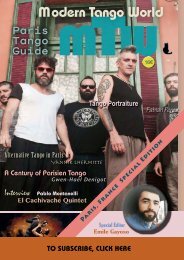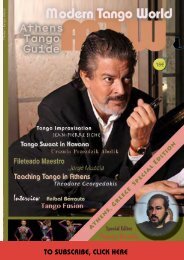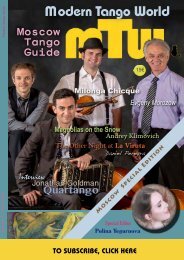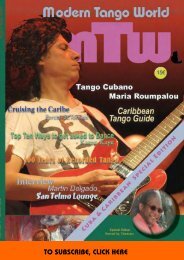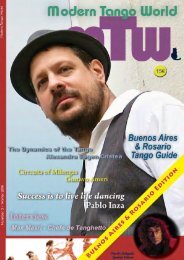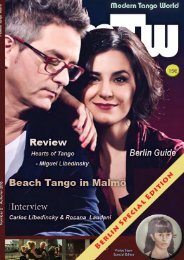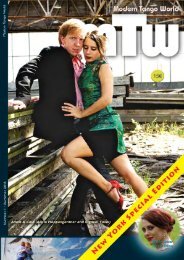Modern Tango World #4 (Bucharest, Romania)
Romania Special Features Romania’s Modern Tango Scene Dragos Samoil 3 An Act of Beauty Laura Iaru 6 Guitar Man Alexandru Eugen Cristea 12 Guide to Tango in Romania 16 The Ladies of Guardia Viejo Renato Mantioni 20 Interview with Miguel di Genova Marco Buso 24 Tango Addiction Kiran Bajaj Sawhney 28 New Tango Music Arndt Büssing 32 The Obamas Tango in Buenos Aires 38 DJ/VJ-ing - Victroleras, Tandas & Cortinas Igor Shpigelman 40 Tango Moves - Abrazos Raymond Lauzzana 44 Letters to the Editor 47
Romania Special Features
Romania’s Modern Tango Scene Dragos Samoil 3
An Act of Beauty Laura Iaru 6
Guitar Man Alexandru Eugen Cristea 12
Guide to Tango in Romania 16
The Ladies of Guardia Viejo Renato Mantioni 20
Interview with Miguel di Genova Marco Buso 24
Tango Addiction Kiran Bajaj Sawhney 28
New Tango Music Arndt Büssing 32
The Obamas Tango in Buenos Aires 38
DJ/VJ-ing - Victroleras, Tandas & Cortinas Igor Shpigelman 40
Tango Moves - Abrazos Raymond Lauzzana 44
Letters to the Editor 47
Create successful ePaper yourself
Turn your PDF publications into a flip-book with our unique Google optimized e-Paper software.
Shortly after that, I went back to Buenos Aires, where<br />
I formalized the project into its actual form together<br />
with some Argentinean musicians. We began playing<br />
at milongas. In 2004, our first album was produced.<br />
In 2006, when the album was already pretty famous,<br />
we did our first European tour in Germany, Holland,<br />
Turkey, Greece and Poland. I can say that everything<br />
started from there.<br />
MTW: In your opinion, what are the aspects that<br />
differentiate Otros Aires from the many other electrotango<br />
bands?<br />
Miguel Di Genova: I believe that Otros Aires explores<br />
tango music from its origins to present day<br />
more than every other electrotango band. Other<br />
artists tend to move from Piazzolla’s tango nuevo<br />
heritage, trying to bring it forth in many ways. I have<br />
always liked traditional tango, instead. Since the beginning,<br />
I have been interested in exploring all of<br />
tango’s musical history, from Angel Villoldo to Astor<br />
Piazzolla, as an extended basis for Otros Aires music.<br />
MTW: In many occasions Otros Aires calls itself an<br />
electronic-archaeological project at the service of tango.<br />
Can you explain this definition?<br />
Miguel Di Genova: This definition comes from<br />
the history of the project and from its development<br />
process. At the beginning I was very interested in discovering<br />
and analyzing old recordings. Many of them<br />
weren’t much used in milongas. I like to research the<br />
tango music that was unknown to the general public,<br />
and to select my favorite tunes among the tracks I<br />
got to listen. In other words, I enjoyed listening to<br />
music that could bring me to the Golden Age, as if I<br />
was doing some sort of musical archaeology.<br />
Using samples comes from this research, because<br />
their function is to let the 21st-century listener feel<br />
what it is like to connect him or herself with another<br />
era, via the mere insertion of a sound, a word,<br />
a sentence directly coming from that era. On the<br />
other hand, I don’t usually write songs as if I am living<br />
in the 1930’s.<br />
I could play a song from the Golden Age of tango, but<br />
writing a song like if it came from the 30’s would look<br />
very odd to me. There are musicians who do that, but<br />
I prefer to explore contemporary topics while connecting<br />
them directly to tradition using samples. This<br />
is clear when you listen or read my lyrics, in which I<br />
tend to talk about today’s social matters.<br />
MTW: Speaking of composition, how do you approach<br />
songwriting for Otros Aires?<br />
Miguel Di Genova: Some themes come from<br />
pure improvisation. This happens when the band<br />
gets together and looks for new musical inspiration<br />
by simply playing around with chords and melodies.<br />
We then proceed to develop themes from the most<br />
interesting ideas. At other times, songs are developed<br />
from an initial idea, like a fragment of music or lyric,<br />
which pops up practically out of nowhere.<br />
In both cases, it is clear that nobody knows how the<br />
first idea will look like until the song takes its final<br />
form. This is because in composing a song the will of<br />
the song itself is as important as the will of the composer.<br />
Music wants to become something, and it is<br />
necessary for the composer to be able to listen to its<br />
needs. The same applies to setting up an album: you<br />
can have a general idea of how the flow of songs will<br />
look like. But, the final product could be very different<br />
from that first idea.<br />
MTW: Otros Aires is very interested in dancing. It is<br />
clear not only in the music, but also in the lyrics, in<br />
the graphic art of the albums, and in your live performances<br />
at milongas. How do you feel about dancing<br />
to your music? What do think about the contemporary<br />
neo-tango fusion dancing?<br />
Miguel Di Genova: I am generally interested<br />
in creation in all its possible forms. All art is alive<br />
and moving. As it happens, people move and mix<br />
together to create new dance with new and peculiar<br />
traits, so it happens in art. I believe that music<br />
should learn from any other kind of music. The<br />
same applies for dancing.<br />
— 27 —




